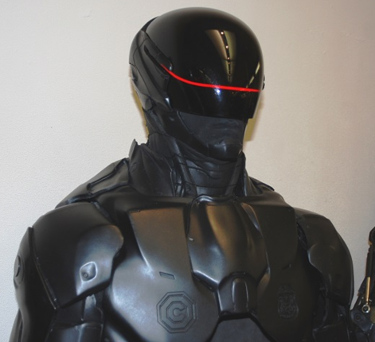 |
| July 08, 2014 | Volume 10 Issue 26 |
Designfax weekly eMagazine
Archives
Partners
Manufacturing Center
Product Spotlight
Modern Applications News
Metalworking Ideas For
Today's Job Shops
Tooling and Production
Strategies for large
metalworking plants
3D printing is the 'master tool' for creating latest RoboCop suits

RoboCop helmet visor, including striking red strip designed by Legacy Effects, created on Objet Connex multi-material 3D Printer using VeroClear material.
One of RoboCop's biggest allies is 3D printing.
Jason Lopes, Lead Design Engineer at Los Angeles-based Legacy Effects, the creators of the RoboCop main suit in this year's blockbuster movie remake, says that 3D printers played the role of the "master tool" in making the futuristic armor.
Using Stratasys' high-resolution Objet Connex multi-material 3D printing technology, Legacy Effects produced every aspect of the RoboCop suit -- from helmet to boots -- as master mold patterns. These pieces were then molded and cast into other materials to create variants of the suit depending on the requirements of each scene.
In addition, some versions of the suit used in the movie were composed of as much as 90 percent actual Stratasys 3D-printed parts. For example, the striking visor, which forms part of the helmet on the black version of the RoboCop suit, features a gleaming red strip; the entire final-version visor used in the movie was 3D printed with Stratasys transparent (VeroClear) material.
Video: Jason Lopes from Legacy Effects describes his experience creating the suits and helmets for the RoboCop movie using Stratasys 3D printing.
The only option for reproducing fine detail
According to Lopes, RoboCop's chest-armor piece best exemplifies how the use of 3D printing technology overcomes certain challenges that can affect production methods.
"First, in terms of the size of RoboCop's chest piece specifically, only Stratasys' 3D printing technology would allow us to print something at the actual size; the part virtually fills the entire build-tray," Lopes explains.

RoboCop's chest piece includes areas that feature extremely high levels of detail -- something only achievable with Stratasys' PolyJet 3D printing technology, says Legacy Effects.
"Second, the same part comprises a blend of smooth areas, as well as other areas that feature an extremely high level of detail, such as the police badge and other logos, which we needed to retain for the molding process. There isn't a technology currently available beyond that provided by Stratasys that affords us this level of intricate detail, together with the hard surface modeling of the shells all together in one print."
In addition to creating the RoboCop suit, Legacy Effects was also involved in 3D printing both master molds and prototype parts for the 'Exo-suit' featured in the movie. These prototype pieces included fully functional spring-operated fingers that were printed in a single build using multi-materials on the company's Stratasys Objet Connex 3D printers.
Video: RoboCop Exo-suit video demo trailer.
Smoother workflow and greater flexibility over traditional production methods
Using Stratasys' 3D printing technology, the team at Legacy Effects is able to work much faster and more efficiently than it could in the days when it produced parts by hand.

3D printing was also used to help create real-world models of the humanoid EM-208s for the film. The humanoids, which are ground troops, were done in CG in the movie, but physical models were made to be used as stand-ins and for promotional purposes. The EM-208s shared many design characteristics of the RoboCop suit, including the visor with glowing strip.
"Doing everything by hand meant that we couldn't run tests, as it would have taken forever," says Lopes. "Also, 3D printing allows us to work in symmetry, which enables us to build an entire left side of a suit, then mirror it and output the right side as well, all from one file with the click of a button. You can't do that by hand."
Despite the recent economic downturn still having an impact on studio budgets, customer high expectations require shorter production times, regardless of the all-to-commonplace 11th-hour changes. For Lopes, 3D printing's ability to speed up processes, as well as the capability to make late changes, has revolutionized the way Legacy Effects operates.
"This is where 3D printing comes to the fore by meeting such pressures head on," says Lopes. "If we see something's not working, or we're asked to make a design change, we can make another iteration, go to an open 3D printer, and be printing two simultaneous tests within an hour. We go to lunch, come back, and it's done. It doesn't get better than that."
"Legacy Effects' use of multi-material 3D printing as its solution of choice is indicative of how the technology is becoming increasingly integral to filmmaking," says Bruce Bradshaw, Director of Marketing, Stratasys North America. "The ability to rapidly 3D print all materials together in one single print run meets the film industry prerequisite to save time and money. But the real show-stealer is Stratasys' ultra-fine 16-micron-layer 3D printing. In the special effects world, fine detail and true-to-life models and parts are the industry standard, and our Connex multi-material 3D printing technology continues to be a top performer among designers and engineers."
Video: Legacy Effects talks more about the suit development.
Source: Stratasys
Published July 2014
Rate this article
View our terms of use and privacy policy
